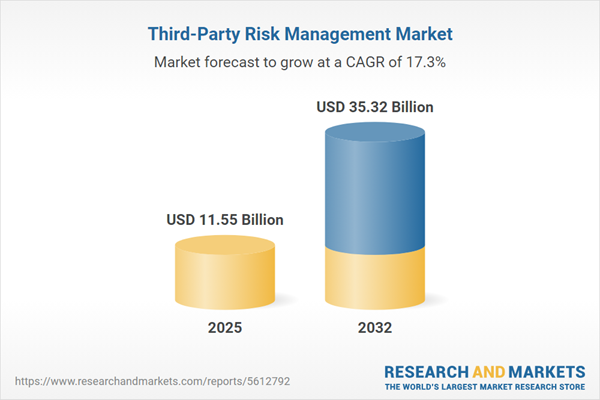Speak directly to the analyst to clarify any post sales queries you may have.
As organizations face increasingly intricate supplier ecosystems and heightened regulatory expectations, the third-party risk management market emerges as a critical partner for senior leaders seeking efficient oversight and greater operational confidence. Modern platforms adapt to evolving compliance requirements and external threats, supporting organizations in their pursuit of stronger supplier management frameworks and agile operations.
Market Snapshot: Third-Party Risk Management Market Trends
The third-party risk management market was valued at USD 9.86 billion in 2024, with projections reaching USD 11.55 billion by 2025 and USD 35.32 billion by 2032. This growth, fueled by a compound annual growth rate of 17.28%, highlights robust market momentum.
Driving these trends are expanding compliance obligations and the complexities of interconnected supplier networks. Organizations in financial services, healthcare, and IT are increasingly investing in digital risk platforms designed to automate supplier assessments and support transparent oversight. As risk landscapes shift, integrated solutions are enabling enterprises to efficiently maintain controls and drive continual improvement in supplier oversight strategies.Scope & Segmentation of the Third-Party Risk Management Market
- Deployment Types: Cloud-based platforms, including public, private, and hybrid models, as well as on-premises solutions, address a range of security and compliance needs while supporting scalability for diverse business environments.
- Component Solutions: Core offerings integrate software platforms, consulting services, and automated assessment tools to help organizations strengthen compliance processes and streamline critical risk operations.
- Organization Sizes: Solutions scale from small and medium-sized enterprises to large multinationals, supporting a breadth of risk profiles and organizational complexity.
- Industries: Banking, healthcare, manufacturing, financial services, IT, telecom, and retail all require dedicated tools that can meet industry-specific compliance requirements and operational priorities.
- Risk Types: Coverage extends across compliance, data privacy, financial, operational, workforce, and business continuity risks, ensuring organizations have comprehensive oversight for every third-party relationship.
- Solution Types: Corporate consulting aligns organizational frameworks to business goals; managed services deliver ongoing risk oversight; software enables customizable, sector-tailored deployment options.
- Regions: Leading providers tailor solutions for the Americas, Europe, Middle East, Africa, and Asia-Pacific, adapting to regional regulatory frameworks, supplier practices, and cultural dynamics.
- Key Companies: Market innovation is driven by IBM Corporation, SAP SE, MetricStream, RSA Security, OneTrust, NAVEX Global, ProcessUnity, Coupa Software, Prevalent, and BitSight Technologies.
Key Takeaways for Senior Decision-Makers
- Comprehensive risk management platforms enhance supplier visibility, enabling quick identification and remediation of vulnerabilities across both global and local supply chains.
- Automation and advanced analytics reduce manual effort, accelerate risk detection, and foster ongoing compliance, even with frequent regulatory and supply chain shifts.
- Continuous monitoring of third-party relationships helps organizations proactively respond to business interruptions and fast-changing operational risks.
- Incorporating ESG criteria within due diligence aligns supplier management with global sustainability and responsible sourcing standards.
- Modular and managed solutions allow rapid adaptation of risk frameworks, helping organizations remain equipped as their supply ecosystems evolve.
Tariff Impact: Adapting Strategies to U.S. Regulatory Shifts
Recent changes to U.S. tariff policies have prompted organizations to reevaluate sourcing and diversify supplier networks. Leading risk management platforms now deliver real-time analytics, empowering procurement and supply chain leaders to assess tariff impacts, examine nearshoring or reshoring scenarios, and swiftly adapt to evolving trade regulations. These capabilities support operational continuity and help mitigate supply chain disruptions during regulatory changes.
Methodology & Data Sources
This analysis draws on executive interviews, subject matter expert engagements, and comprehensive quantitative surveys. Rigorous data integration and peer review ensure results that accurately reflect technology use and best practices in third-party risk management.
Why This Report Matters
- Offers actionable insights and benchmarking guidance, allowing organizations to reinforce compliance frameworks and drive effective supplier risk mitigation.
- Enables firms to adapt third-party risk strategies in response to ongoing digital transformation and dynamic global supply networks.
- Facilitates timely identification of emergent risks, strengthening operational resilience as business and technology environments shift.
Conclusion
Deploying advanced third-party risk management solutions empowers organizations to address complex supply chain and compliance issues with confidence. This foundational approach supports resilient operations and sustained stakeholder trust in a dynamic business landscape.
Additional Product Information:
- Purchase of this report includes 1 year online access with quarterly updates.
- This report can be updated on request. Please contact our Customer Experience team using the Ask a Question widget on our website.
Table of Contents
3. Executive Summary
4. Market Overview
7. Cumulative Impact of Artificial Intelligence 2025
Companies Mentioned
The companies profiled in this Third-Party Risk Management market report include:- IBM Corporation
- SAP SE
- MetricStream, Inc.
- RSA Security LLC
- OneTrust, LLC
- NAVEX Global, Inc.
- ProcessUnity, Inc.
- Coupa Software Inc.
- Prevalent, Inc.
- BitSight Technologies, Inc.
Table Information
| Report Attribute | Details |
|---|---|
| No. of Pages | 183 |
| Published | October 2025 |
| Forecast Period | 2025 - 2032 |
| Estimated Market Value ( USD | $ 11.55 Billion |
| Forecasted Market Value ( USD | $ 35.32 Billion |
| Compound Annual Growth Rate | 17.2% |
| Regions Covered | Global |
| No. of Companies Mentioned | 11 |









